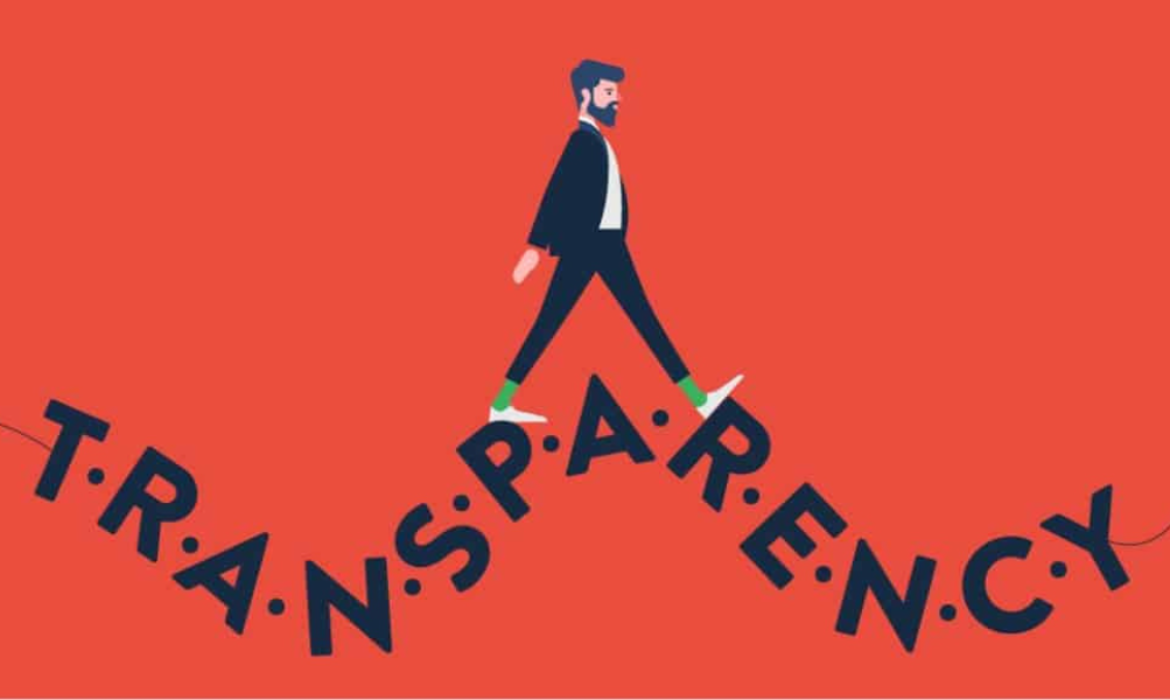Madison World’s Milan Modi Speaks: Crafting Success in Digital Advertising
Milan Modi, a Business Director (Digital) at Madison World is a seasoned professional with over 8 years of expertise in Paid Digital Media. He has garnered accolades as India’s Best Marketers & Planners and “Young Guns Advertising Male.”
With a track record of 72+ awards for groundbreaking campaigns, including Pidilite, Raymond, and McDonald’s, Milan is a visionary in leveraging Metaverse, NFTs, and AR filters. In this interview, he shares strategic insights into the evolving digital landscape, audience targeting post-cookie era, and innovative approaches to digital advertising. His journey exemplifies a commitment to excellence, making him a dynamic force in the advertising and media industry.
Can you take us through your professional journey and share some of the memorable moments you encountered in your decade-long tenure in the advertising industry?
First of all thank you very much for gracing me with this occasion, thanks for allowing me to be a part of this noble program where you share the experience of some of the finest minds in the country, so others can benefit from it.
I come from a local Mumbai background and was fortunate enough to complete my formal education in this same city. Numbers have always excited me, and I’ve been surrounded by them throughout my journey. Whether it was my first internship at HSBC Bank or my initial professional experiences at Fractal AI, Publicis Group, and Madison World, I’ve consistently been in fields where numbers are paramount. While the early years were dominated by the left brain, the integration of creative and media has now engaged my right brain as well.
Reflecting on some memorable moments in my career, I’d like to highlight my first major digital marketing campaign for the largest bank in India, HDFC Bank. We achieved tremendous success in terms of media branding and performance metrics, earning numerous case studies and awards. It marked the significant announcement of their Personal Loan Campaign.
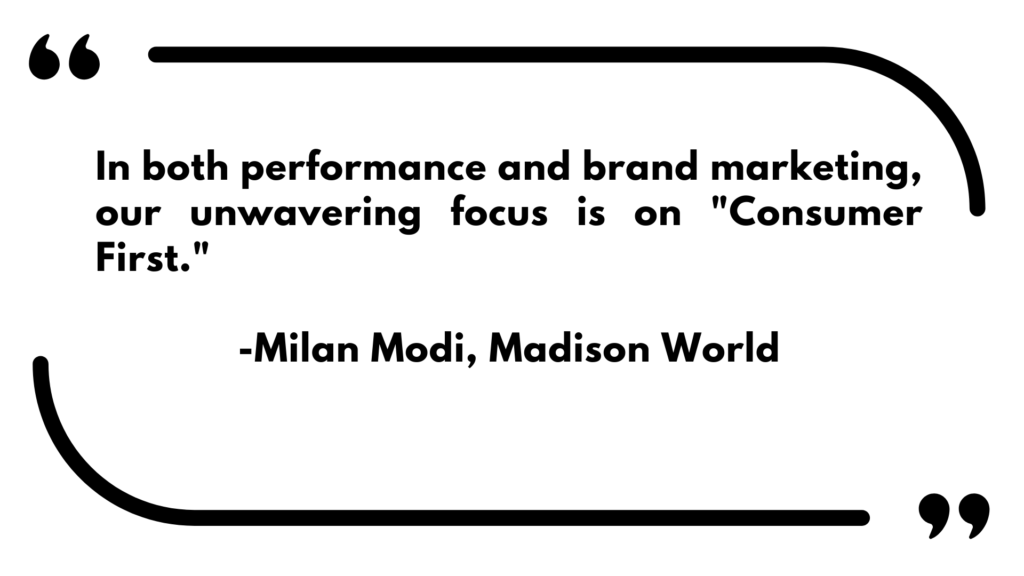
You oversee branding and performance marketing responsibilities for various well-known brands across several verticals. How different or similar are the strategies that you formulate for them?
In both performance and brand marketing, our unwavering focus is on “Consumer First.” The ongoing battle between push and pull strategies remains a constant consideration. In our approach to brand marketing, we go beyond mere media attention, ensuring that our messages are not only contextual but also deeply relevant to the end consumer. The era of one-size-fits-all is long gone, with marketers now actively tailoring communication to meet the unique needs of each consumer—something every marketer, being a consumer themselves, can relate to. In our efforts, we consistently adhere to the fundamental principles of reach, frequency, continuity, impact, and weeks on air.
Performance marketing has undergone a significant transformation. While Google Search stands out as a primary choice for every marketer, we strategically engage with consumers on other intent-based platforms before transitioning. Techniques such as lead nurturing, lead scoring, UI/UX optimization, post-click experience enhancement, and regular follow-ups, though seemingly basic, play a pivotal role in achieving the ultimate conversion. To excel in the performance game, we also prioritize regional creative, landing page quality, and a well-established call center setup, ensuring a seamless and exceptional consumer experience.
With so many ad content options such as text, images, and audio available to advertisers, what according to you is the most effective in translating the message to audiences? What are some of the techniques you use to track campaign performance at Madison World?
With user touchpoints increasing daily, and every app on smartphones or any available wall serving as an ad unit, it’s crucial to track each touchpoint. One fundamental truth that has consistently worked for us, and that we strongly believe in, is the power of customization. Whether it’s a video, audio, text, or image banner, our aim is to tailor the communication on each media/platform according to its best practices.
For instance, the rendition of a video on Instagram Reel (or YouTube Shorts) differs from one on YouTube Home Feed or an OTT Ad. Similarly, an ad on Sharechat/Moj varies from that on Television. Even in Cinema or outdoor settings, customizations are recommended. While the core message remains the same, the rendition adapts to each media/platform.
When it comes to measurement, we compare the platform benchmark to the X Category Benchmark against our campaign numbers to evaluate its effectiveness. Search Lift, Brand Lift, MediaMixModelling, and Sales Lift are also some of the ways we gauge campaign effectiveness.
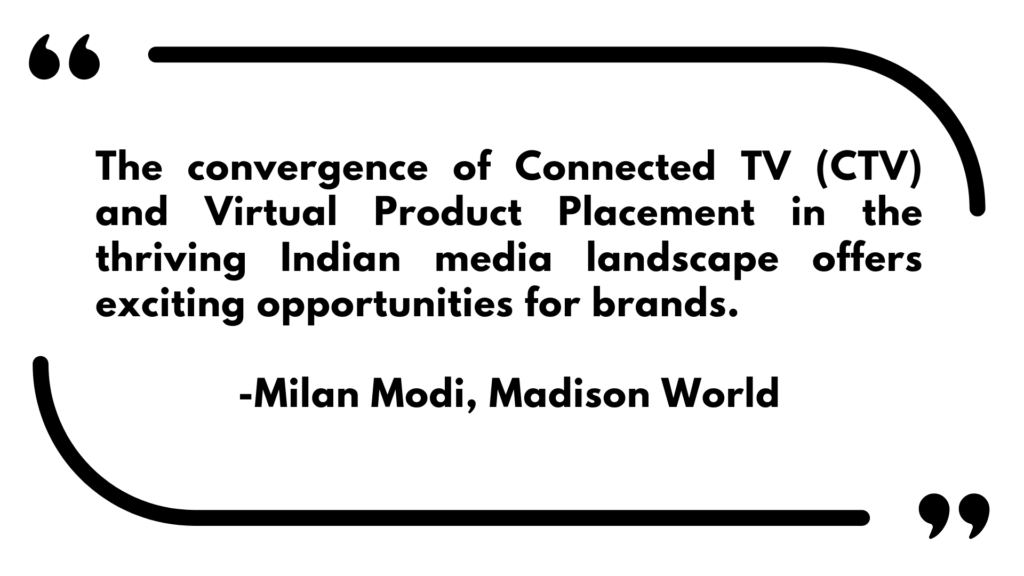
As Google’s third-party cookies will soon be banned permanently, how have you seen it affect the digital landscape and what potential setbacks do you see?
Yes, this has been the buzzword for some time, and the juggernaut Google has been postponing the date of cookie deprecation. But in my view, the demise of third-party cookies will reshape the way targeting is done in the digital landscape.
Shift towards first-party data: With third-party cookies becoming obsolete, there will be a heightened focus on first-party data. Brands and advertisers will need to invest in building and leveraging their data to maintain effective targeting and personalization strategies. We have been emphasizing the importance of advertisers owning the data of visitors coming to our landing page. This first-party data will be invaluable when the cookies sunset.
Dominance of Walled Gardens: As third-party cookies decline, the dominance of walled gardens (platforms with closed ecosystems) might increase. This could potentially limit advertisers’ ability to gather cross-platform insights and data.
Rise of New Ad-Tech Solutions: The industry is likely to witness a surge in innovation as ad-tech companies develop alternative solutions for targeting, attribution, and measurement that don’t rely on third-party cookies.
Challenges in Attribution Modeling: Attribution Modeling Complexity: Attribution models heavily rely on third-party cookies to track user journeys and attribute conversions. The absence of these cookies may lead to challenges in accurately attributing conversions across various touchpoints in the customer journey.
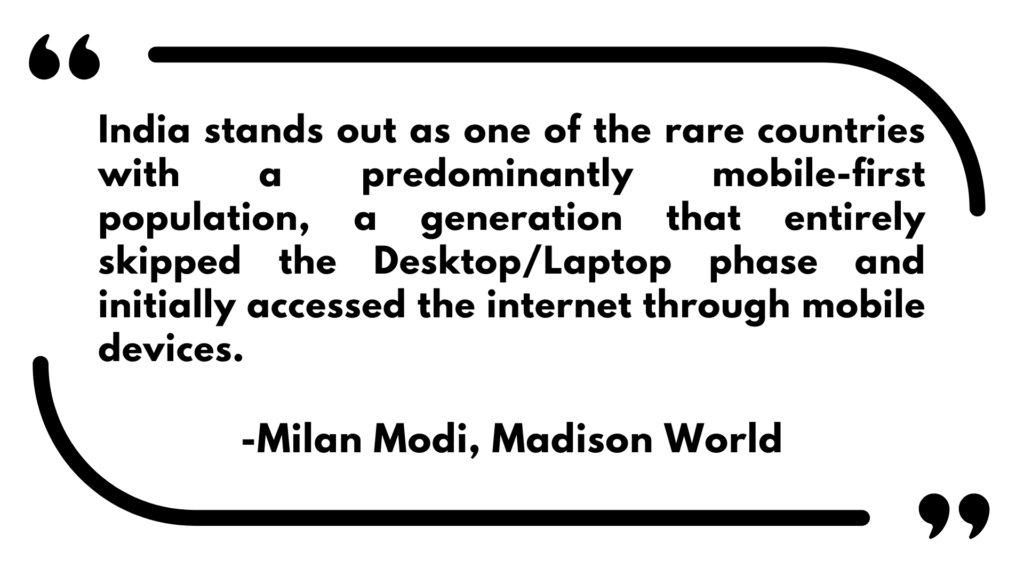
What audience-targeting KPIs do you look to achieve across biddable platforms? What changes do you oversee in this field and how have you prepared to align with them?
Achieving effective audience targeting across biddable platforms involves setting and monitoring key performance indicators (KPIs) aligned with campaign objectives and business goals. Here are some common audience-targeting KPIs and considerations for overseeing changes in this field:
1.Click-Through Rate (CTR), Conversion Rate, Cost Per Click (CPC), Cost Per Acquisition (CPA), CPM, and Engagement Rate Metrics.
We analyze each audience’s performance based on the above and make conscious decisions to continue, amplify, or discontinue the targeting.
2.Changes in Audience Targeting and Preparation:
Privacy-Focused Changes: There’s an increasing emphasis on privacy regulations and restrictions on user tracking. Some platforms already don’t allow targeting iOS users.
Cookie Depreciation: The phasing out of third-party cookies impacts cross-site tracking, necessitating a focus on building and leveraging first-party data, exploring alternative identifiers, and adapting attribution models. Google Analytics 4 has introduced “Enhanced Conversion tracking,” which, though in initial phases, has the potential to be a game-changer.
Machine Learning and AI Advances: With the buzzword of AI, we’ll witness the growing use of machine learning algorithms for advanced audience targeting. Numerous partners work in the field of AI technologies, collaborating with Meta and Google platforms for further optimization.
Cross-Channel Integration: Recognizing each consumer as one, advertisers now need to develop integrated marketing strategies, align messaging across channels, and utilize platforms that support cross-channel targeting and measurement.
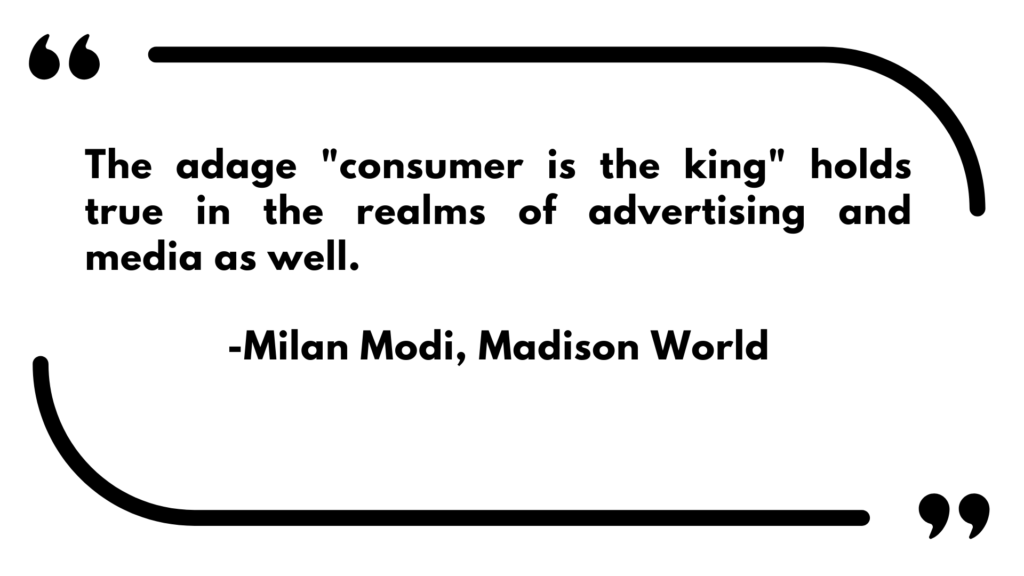
In the Indian media landscape, CTV is booming, and brands are utilizing Virtual Product Placement. How do you think brands could leverage these technologies together? What are some challenges or potentials?
The convergence of Connected TV (CTV) and Virtual Product Placement in the thriving Indian media landscape offers exciting opportunities for brands. Leveraging these technologies together can elevate the overall viewer experience, boost brand visibility, and drive engagement. CTV stands out as one of the fastest-growing mediums in India, with over 20 million households embracing CTV connections, reflecting a significant trend in cord-cutting.
Immersive Brand Integration: Brands can seamlessly integrate virtual products into CTV content, providing viewers with an immersive and non-intrusive experience. It’s crucial, however, to strike a balance, as it may sometimes come across as intrusive and non-authentic or gimmicky.
Audience Targeting and Personalization: Brands are increasingly adopting customized communication strategies, tailoring content to different CTV audiences based on geographical locations and linking it to the nearest store in that market. This approach proves effective in precisely targeting CTV audiences.
Interactive and Shoppable Experiences: A simple integration of a QR code allows brands to directly redirect users to the Direct-to-Consumer (D2C) website for convenient purchases.
Branded Content Integration: While content is hosted on a brand’s channel, certain partners virtually integrate the brand into the show at an economical cost. This subtle integration organically enhances the brand’s visibility. Additionally, collaborate with content creators to seamlessly integrate virtual products into their productions, leveraging their creativity and storytelling skills.
Smartphone usage has increased in India, thanks to affordable and accessible internet. How important is mobile advertising to reach target audiences today?
As per industry reports, India currently boasts the most affordable per GB data prices globally. The prevalence of low-cost smartphones and internet accessibility on feature phones has transformed the smartphone from a luxury to a basic necessity. In 2023, TV and Digital collectively constitute over 70% of the Advertising Expenditure (AdEx). Digital AdEx, surpassing TV, is anticipated to reach Rs 43,000 crore by the end of the year.
India stands out as one of the rare countries with a predominantly mobile-first population, a generation that entirely skipped the Desktop/Laptop phase and initially accessed the internet through mobile devices.
Targeting: Digital Marketing offers precise targeting, allowing brands to save marketing expenses by reaching only specific demographics rather than mass audiences.
Measurement: The extensive measurement capabilities of Digital Marketing have made it an integral part of every marketer’s media mix.
On a Pan India scale, YouTube’s reach is approximately 50% of the TV universe. Notably, in markets like Bihar, YouTube’s reach has surpassed that of TV.
What are some of the campaigns that have stood out for you and why? What were some of the takeaways from these campaigns and how were the different from any others?
- Content: The Fevicol 60 years celebration campaign marked a paradigm shift in how audiences consume content. We pioneered a new approach to market a 90-second film on various media platforms.
- Tech: In a category as challenging as Condoms, where major platforms like Star TV, YouTube, and Meta impose advertising restrictions, we changed the marketing strategy by creating NFTs and Metaverse for the brand called Kamasutra Condoms.
- Multimedia: For Raymond, we employed a combination of online and offline signals to leverage the surge in user queries, marking a first-ever achievement.
Would you like to give a word of advice to young professionals looking to venture into the advertising and media industry?
For young individuals aspiring to pursue a career in advertising and marketing, the first step is to understand what excites you every day. Identify what motivates you to go to the office and what you can envision doing for 30 years without getting bored.
Once the answer is clear, delve into understanding consumer behavior within the respective category. This aspect is crucial, and those who can decipher it are clear winners. All marketing strategies, be it creative, communication, or media, revolve around consumer insight.
The adage “consumer is the king” holds true in the realms of advertising and media as well.
DoubleVerify Expands Media Authentication on Meta
DoubleVerify, a leading software platform for data, analytics, and digital media measurement, announced that it has expanded its brand safety and suitability coverage on Meta. It will help to measure feeds and reels on Facebook and Instagram in addition to other platforms. Global advertisers will be able to safeguard their brand equity. Moreover, they can independently verify the quality of their campaigns in these captivating, user-generated media environments with the release of this feature.
Comprehensive media buys measurement
DV’s brand safety and suitability solutions are now available for Facebook and Instagram Feeds and Reels. Media buys on Meta can now be measured comprehensively across a variety of devices, placements, and formats. To achieve a balance between protection and scale, DV’s AI-powered classification technology, which draws on more than 15 years of experience, is trained on a large volume of data signals and is based on strong content policies.
Benefits to Advertisers
Advertisers will benefit from:
Proprietary technology
DV uses AI to guarantee the most precise content classification on a large scale. Using DV’s Brand Safety Floor and Suitability Tiers, which are mapped to the GARM framework, brands can authenticate the content surrounding their promotion. DV classifies content directly above and below the placement of ads.
Comprehensive coverage
Regarding Instagram Feed, Instagram Reels Ads, Facebook Feed, Facebook Reels Ads, Facebook in-stream video, and Audience Network, DV now provides a more comprehensive measure of media quality.
Trusted measurement
Businesses can relax knowing that their Facebook and Instagram campaigns are authenticated by the top independent third-party verification provider in the industry.
Read More: DoubleVerify Announces Expanded Measurement Coverage with S2S Integration
Through DV Pinnacle, the company’s unified service and analytics reporting platform, advertisers can access measurement data and insights to track and improve the effectiveness of their Meta ads campaigns.
DV’s Viewability Solutions
In 2017, DV joined Meta’s measurement partnership program, providing Facebook and Instagram fraud and viewability solutions. In addition to expanding verification to In-Stream Reserve, DV introduced brand safety and suitability integration with Facebook in 2019. Furthermore, it offered additional tools to increase efficiency and control. Viewability and fraud verification were added to DV’s media quality authentication for Facebook and Instagram reel inventory in 2023. This was the most recent extension.
Here’s what they said
Mark Zagorski, CEO, of DoubleVerify, said,
The expansion of DV’s industry-leading, AI-powered classification technology to Facebook and Instagram Feeds and Reels underscores our commitment to helping brands ensure safe and suitable ad environments across all channels. The protection of brand reputation online is an important factor in maximizing campaign performance for the global brands we serve.
Samantha Stetson, Vice President of Client Council and Industry Trades at Meta added,
DoubleVerify’s expansion of brand safety and suitability solutions across Facebook and Instagram is an important step forward in our ongoing efforts to foster digital transparency and trust within our advertising environments. Responsible marketing is a key priority at Meta – and we are delighted to expand our partnerships with this important solution.
Read More: DoubleVerify Includes YouTube Shorts in its Brand Safety Measurement Expansion
Exploring Ad Landscape Shifts: In conversation with Deepika Bansal from Dentsu X
The accomplished AVP Investment at Dentsu X, Deepika Bansal, discusses her professional background in the transitioning field of digital marketing. With more than 15 years of experience, she leads us on an exciting journey through the world of advertising.
In this exclusive interview, she discusses embracing changes, emerging technologies, and adaptability from her point of view.
With a career journey spanning different brand categories over the last 15 years, can you tell us more about your trajectory and your experience as the AVP Investment at Dentsu X?
Fortunately, I’ve gained extensive experience across diverse brand categories like FMCG, BFSI, Retail, and e-commerce. Auto, in particular, has been a thrilling space that provided me the chance to work with Dentsu. My journey with Dentsu commenced in 2017, initially focusing on a prestigious Auto client and gradually expanding to handle multiple other key accounts. The experience with Dentsu has been a blend of challenges and enrichment, contributing to both professional and personal growth. Currently, I lead the offline buying vertical for Dentsu X. Embracing change, I’ve diversified into digital, integrated, and influencer marketing campaigns. The team’s dedication is underscored by accolades, with a recent ‘Gold’ at ACEF for the #drivenbysafety campaign, recognized for the most admired social message and best use of Celebrity. Reflecting on these achievements, they not only affirm our work but also inspire us to continue pushing boundaries.
Has your experience in the other fields influenced your strategy-making decisions in your current role?
In my current role, my experience in other fields has proven invaluable in shaping my decision-making strategy. I draw on lessons learned from past experiences to make more informed and well-rounded decisions. This broader perspective enables me to consider different approaches and adapt to various situations effectively.
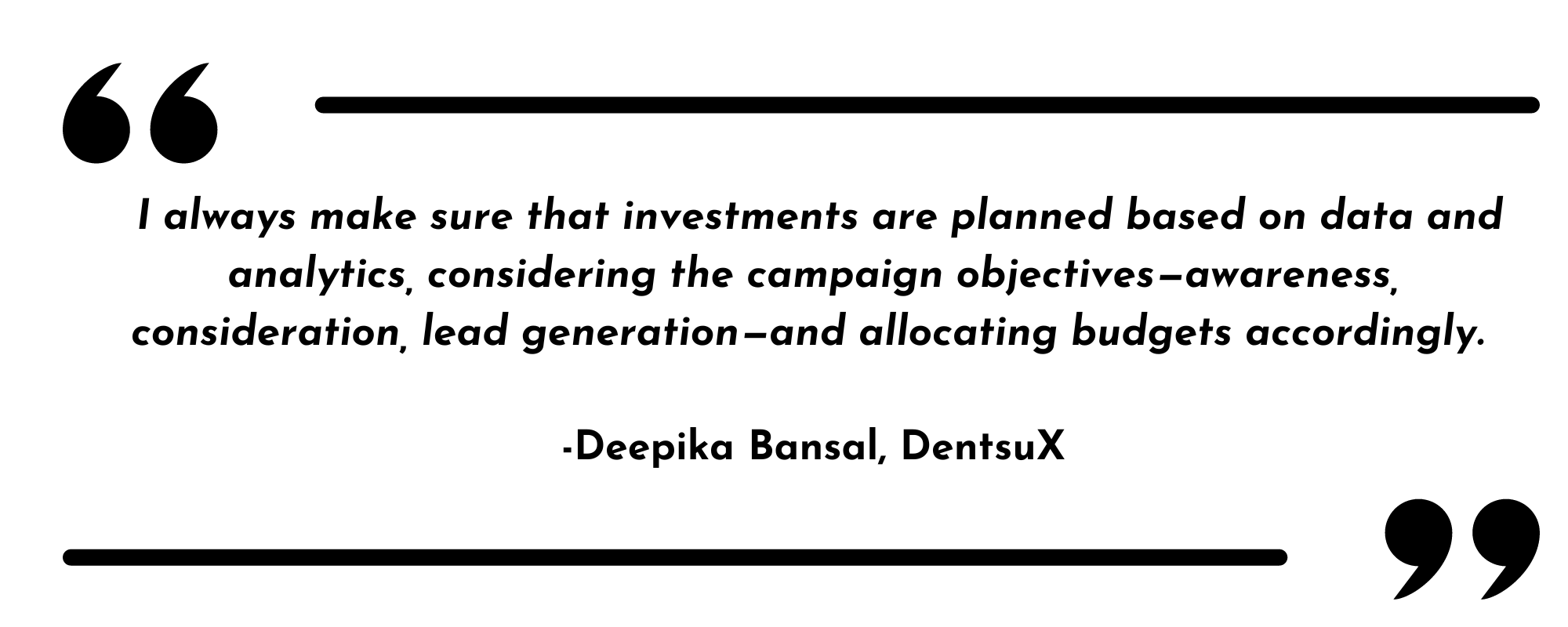
How do you make sure that the investments you make for media planning are sustainable and help in achieving marketing objectives?
I always believe that media investments are not just about spending money but about achieving specific outcomes that support the overall marketing objective. Data is the key to success. I always make sure that investments are planned based on data and analytics, considering the campaign objectives—awareness, consideration, lead generation—and allocating budgets accordingly. We always focus on cost-effective solutions for clients and ensure ethical practices in advertising.
What are your thoughts on the rise of digital media? Do you think it diminishes or undermines the value that traditional media brings?
The rise of digital media has certainly transformed the media landscape, providing great accessibility, immediacy, and interactivity, but it also raises concerns over credibility. Traditional media still holds value in terms of rigorous journalism, making it one of the most credible sources. Lately, traditional media has been very innovative, keeping up with trends and technologies. The usage of QR codes and AI are recent examples that brands have incorporated through traditional media as well. So, I would say it is not about diminishing the other but rather complementing each other in an evolving media ecosystem.
What is the most memorable campaign you have carried out and what strategies did you deploy to ascertain that it was successful?
We have executed several good and successful campaigns over the years, and one notable example is “Maruti Suzuki’s #driven by safety.” The key objective was to educate and remind consumers of road safety rules that are conveniently forgotten while driving, while also highlighting Maruti’s safety features in cars. We took an interesting but thought-provoking route, leveraging high-frequency exposure along with the use of celebrities to viralize the message. Additionally, we ran testimonials to build credibility. The results were amazing, and we garnered approximately 46 million reach through radio and social media.
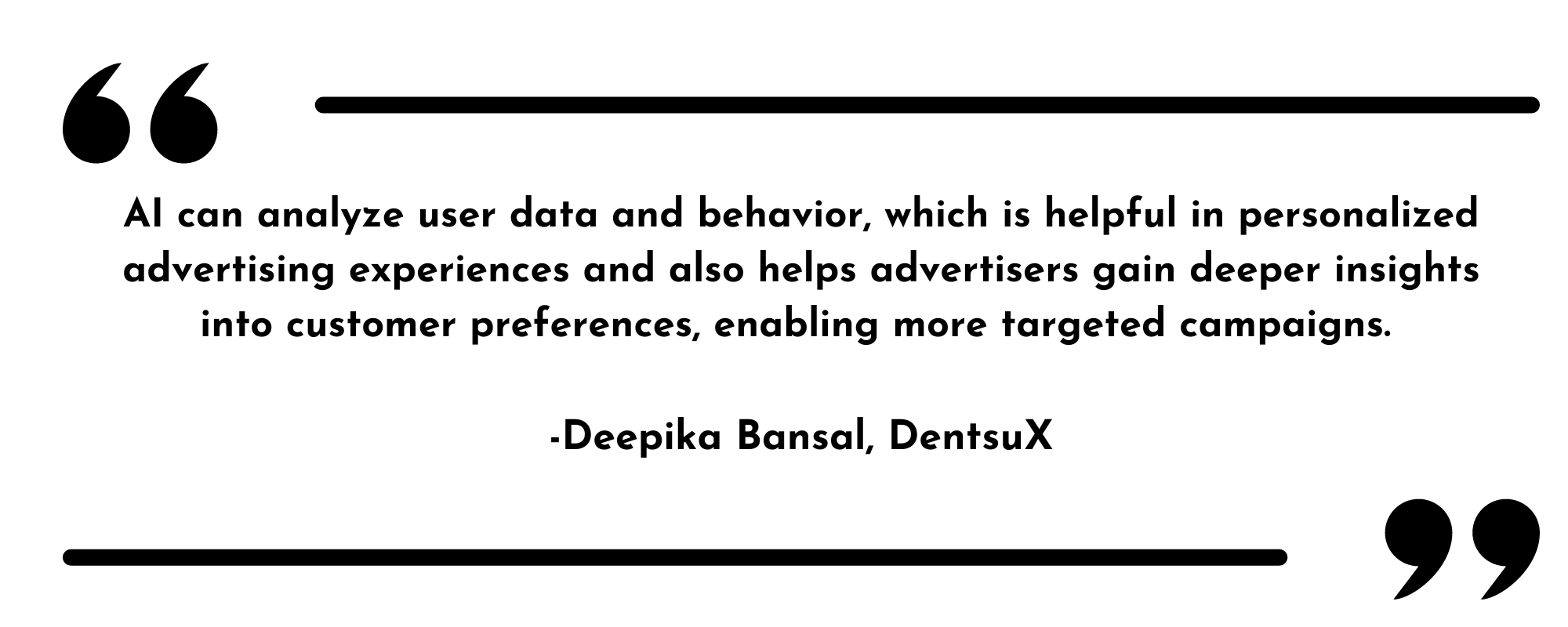
How do you think the expansion of metaverse, AI, 5G technology, and other technological growth in India would revolutionize the advertising landscape?
It is revolutionizing the advertising landscape in many ways. AI can analyze user data and behavior, which is helpful in personalized advertising experiences and also helps advertisers gain deeper insights into customer preferences, enabling more targeted campaigns. 5G enables low-latency interactions and real-time engagement between brands and users in the metaverse, enhancing effectiveness. All of these factors are providing an interactive advertising experience and potentially increasing conversions.
Can you tell us about the research methodologies Dentsu X undertakes to ensure that the media plans align with the marketing campaigns? Which of them is the most effective?
It’s always a point of pride to highlight that Dentsu boasts a range of tools dedicated to understanding consumption habits and audience passion points, and intricately profiling audiences in a manner that is both robust and future-proof. This capability empowers us to plan with precision, adopting a truly targeted and strategic approach. Notable tools include:
CCS: Capturing demographics, psychographics, brand behavior, and touchpoints.
CCS Planner: Leveraging media optimization tools based on business KPIs, integrating the consumer decision journey within the category, and assessing the influence of media touchpoints.
Dentsu Marketing Cloud: Generating real-time insights into consumer behavior in the digital realm.
Dentsu Intelligent Dashboard: An automated intelligent dashboard that comprehensively tracks both our own and competitive activities across various mediums.
Scenario Planner: Facilitating media optimization based on business KPIs, supported by extensive Marketing Mix modeling.
Each tool holds its unique importance and relevance, contributing to our ability to tailor strategies effectively based on specific marketing objectives.
What advice would you give to the upcoming young professionals who are seeking to enter the advertising field?
Always be ready to learn, experiment, and adapt yourself to the changing environment. Keep up with industry trends, emerging technologies, and changing consumer behavior. Last but not least, strengthen your professional network.
Mindshare and Scope3 Develop Emission Scorecard for Digital Campaign
Mindshare, a media services company affiliated with GroupM and WPP, and Scope3, a collaborative sustainability platform that reduces carbon emissions in media and advertising have developed a customized Emissions Scorecard. Clients will benefit from this tool’s ability to comprehend the carbon emissions of their digital media campaigns.
Insights on Carbon Emissions from Digital Media Activities
Mindshare’s clients will have access to real-time carbon emissions data for the first time on their digital media activities at the macro (business category, brand, country, and publisher) and micro (creative format, media type, and ad environment) levels. The Mindshare and Scope3 teams have been working together for the past year and a half to refine the way emissions are measured and develop a cutting-edge emissions reporting tool for brands.
Mindshare Emissions Dashboard
The Mindshare Emissions Dashboard was created with Scope3 to report emissions of digital media activity. This is in accordance with GroupM’s carbon decarbonization methodology. Marketers can thus balance the demands of greener media with those of successful business outcomes.
Read More: GroupM Bolsters Media Decarbonization with SeenThis Partnership
Sustainable Approach
The Mindshare “Report, Reduce, Remove Initiative” included the creation of the Emissions Dashboard. This sustainable step-by-step approach aims to maximize investment in greener choices throughout the media supply chain. Furthermore, it looks to minimize disruption to business requirements. Mindshare is the only organization in the sector dedicated to the Science Based Targets initiative (SBTi). Therefore, as an agency, it must implement its reduction efforts without sacrificing effectiveness.
Carbon emissions from different media sources
A combined 7.2 million metric tons of emissions are produced annually by digital, display, and streaming advertisements, according to Scope3’s Q2 2023 State of Sustainable Advertising report. When broken down by channel, streaming contributes 3.4 million metric tons and display advertising makes up more than half (3.8 million metric tons) of the total amount worldwide.
Here’s what they said
Dhruv Menon, Director at Mindshare said,
By giving marketers a 360-degree view of the carbon impact of their digital media activity, the dashboard enables change-making conversations and discussions with advertising and publisher partners. More importantly, it will also empower media practitioners to make sustainable media buying choices with a goal of eventually reducing 50% of all digital emissions by 2030.
June Cheung, Head of JAPAC for Scope3 stated,
Scope3 emissions data pinpoints exactly where marketers can take simple, yet meaningful, actions to reduce the carbon footprint of their digital advertising. It simultaneously helps the industry more clearly see and de-fund waste across the ad ecosystem. This type of industry-wide change is only possible if marketers have the tools that allow them to make informed decisions. By being able to access emissions data directly alongside campaign data, like the Mindshare Emissions Dashboard, sustainability is no longer an afterthought, it becomes a valuable lever for improving campaigns.
Read More: Magnite Partners with Scope3 to Enhance Advertising Sustainability
26% FDI Extension Provided To The Digital Media By The Union Cabinet
FDI stands for Foreign Direct Investment. Under this, the companies are independent to raise investment via through foreign channels. Earlier, this facility was only available to the print media, and only they were authorized for the FDI.
The step is considered to be bold and resourceful in the direction of obtaining success in the Digital India Campaign launched by Prime Minister, Sri. Narendra Damodardas Modi.

Bestmediainfo
In a statement issued by the Union Minister of the Finance, Mr Piyush Goyal stated: “ Even as foreign direct investment slows down across the globe, we are looking to liberalize norms in the country. We hope India can maintain its position as an attractive investment destination and grow in the coming months.”
The statement was issued, on Wednesday while the Minister was addressing a press conference.
Expanding the scope of FDI and expanding it to 29% for the digital media is indeed seen in a positive light. People in the industry are welcoming it, as there were no such policies in the past. It is speculated that the step will help flourish the digital media in India and motivate platforms to work as an independent entity.
Jehil Thakkar, a partner at Deloitte India, explained the importance by stating that,
“All digital media was simply subsumed under the broader legal entity it was part of, broadcasting or otherwise, This will now allow digital platforms to be unlocked from the bigger companies and seek separate valuation.”
Now, the companies registered under one umbrella(parent company) will be able to register themselves separately. Therefore, they will be independent to raise funds separately for themselves.
The current Government led by Prime Minister Modi has proven itself to be determined, in generating and enhancing the scope of digital media and its platforms for better development of the country ensuring security and development at the same scale. However, the digital media have waited for this opportunity for long now. Whereas, the print media enjoyed the FDI of 25% to 49%.
Digital media have impacted our society at a wider pace. The landmass covered by digital media is far broader compared to the print media. In India, around 1.2 billion people are part of the digital media family. This population include both urban and village residents.
Some people are still unsure if the decision is as fruitful as it seems. They were expecting the percentage of FDI allotted should have been 49%. Raising the FDI to 49% will help to generate more jobs in the industry and create employment for millions. The extra money could have been utilized in the development of multiple sectors including education, entertainment, expanding the scope of digital payment and in developing healthcare industries.
However, according to Manav Sethi, Chief marketing officer at Eros Now, “Earlier there was no FDI restriction in digital media, so the current imposition of 26% is restrictive, and so bad news for the sector,”
Well, the glass filled with water can be seen, as half-filled or half empty! However, people in the digital industry are embracing the decision wholeheartedly and are hoping for a better future of digital platforms and media market in India.
Innovation In Google During The Tough Times Of COVID
While most of the brands are struggling to survive during the tough times of pandemic, Google has set its goals right for the whole year. It is innovating itself without any trouble. Every month Google targets to enhance itself, according to the growing demand of the society. Google makes sure, that it fulfills the need of its users by providing them with exactly what they desire.

Image credit – Business Insider
Recently, Google introduced two new features for its search portals. One of the features is designed, and dedicated to the Black community. The feature will help in the upliftment of the community in society and will aim to end the injustice against them.
Due to the rise of anger in the community against the centuries-long injustice experienced by the community, several brands came forward to show their support towards the community. Google was amongst them.
#BlackLivesMatter!

Image credit – change.org
To fulfill his promise, the CEO at Google, Sundar Pichai recently added a feature to the map and Google search listing.
This feature is launched to empower the Black community. The feature will highlight businesses owned by the Black community helping them grow. However, only those members can avail of the benefit whose business has verified profiles in the US. Also, the business must be owned by a member of the black community.
Those businesses highlighted under this feature will be marked by an image(as shown below). The symbol will signify that the business is owned by a member of the Black community.

It is said that the step was taken to provide a financial boost to the community. It is a foreseen step to finally end the orthodox discrimination towards the community. Google is also partnering with U.S. Black Chambers, inc. To provide better features like Analytics helping the businesses groom and blossom.
In a statement regarding this following statement was issued by Google:
“As part of our $300 million commitment to support under-represented entrepreneurs, we’re integrating the attribute into the digital skills training programs we offer Black business owners through Grow with Google Digital Coaches. And through Google for Startups Accelerator for Black Founders, we’re starting our work with the first cohort of 12 startups.”
Google is keen to develop the feature even more and is seeking ideas internally. According to the management, they have already received more than 500 creative ideas to get this model to develop more brilliantly.
The company is also working on better and much strict “Policies against hate and harassment”
“About this ad”- More power to the user!

Image credit – 9to5Google
With a more transparent approach towards their users, Google has launched a new feature popularly known as “About this ad”.
To implement this feature Google will be launching new tools. It will help the users gain information about the advertisement they are receiving. It will help enhance security and will increase user privacy on the digital platform.
According to Google spokesperson, the vision is designed for a “thriving internet where people around the world can continue to access ad-supported content, while also feeling confident that their data is protected”.
“But in order to get there, we must increase transparency into how digital advertising works, offer users additional controls, and ensure that people’s choices about the use of their data are respected not worked around or ignored.”
Read More: Google Ends All Gossips: Revealed Fee Structure For Advertisement Tools

Image credit – AdEspresso
For a long time now, tech giants like Google are have faced a lot of criticism. Most of those were linked to their explicit behavior when it comes to money and user privacy. After being criticized and called upon several times by different government authorities for blind approach in the business during the usage of advertisers’ money, Google has finally decided to be more transparent with its business policies and proposals.
Therefore, Google shared a list of pricing for its tools used by advertisers for the advertisement. It was a huge step by Google, since before this release, advertisers were kept in the dark about the spent of their share of the money, and the profit earned by Google.
The tools for which Google revealed the prices include, DV360, Google Ads, ad manager, and its publisher tech.
The revealed prices are as follows:
These prices were revealed by Google in a series of articles and blog posts.
The prices are in the ratio of percentage for a $1 amount spent by an advertiser on an advertisement, divided between the publisher and Google.
- Google tech: Publishers – 69%, Google – 31%
- DV360: Publisher – 87%, Google – 13%
- Ad Manager: Publisher – 82%, Google – 18%
- Google Ads: Publisher – 86%, Google – 14%
- Ad sense by Google: 68% share taken by Google of the total spent by the advertiser.
Google has never been so transparent in regards to its prices, the sources say that this new transparent face of Google is due to the ongoing legal hearing conducted by the state attorney general and the Department of Justice.
Read More: Google Updated Its Demand-Side Platform With DV360!

Image credit – marketingland
Innovation has always been the motto of the company. To make sure that the advertisers at Google are equipped with the best tools available in the market, it recently launched its new self-service toolkit known as Display & Video 360.
The tool is launched to change the landscape of the advertisement. Display &Video 360 is a gift to its advertisers by Google.
Earlier, advertisers used the tools to make a hypothetical projection while running an online marketing campaign. The most crucial question that bothered the advertisers was the amount of audience that they will reach with the campaign. To make sure it’s no more a hit and try show for the advertisers, Google launched DV360.
With the DV360, the advertisers can now create a new campaign and check its reach to the audience as the tool provides a duplicate view of the campaign. The duplicate view will help the advertisers view the exact or say a more accurate number of audiences that they will reach with the campaign. Hence, no more blind bets!

Image credit – Matech Today
The tool has better forecasting capabilities, giving the advertisers a glimpse of the future for their campaign. It is also a better solution for the media planners as it provides them with a large proportion of benefits as better access to the tool as they always have a larger role to play.
The most crucial answer answered with the tool is, “how many unique people can I expect to reach with my overall campaign across any open auction display and video inventory as well as YouTube?”
According to Anudeep Pedditi, Programmatic Manager, OMD NZ:
“Once we commit to a reach objective, neither underachieving nor overachieving is an option. Display & Video 360 gives media planners the accuracy they need to effectively plan across all our programmatic campaigns.”
The Tools main aim is to provide the following features to its advertisers:
-
-
-
-
Focus
-
Options For Buying
-
Optimization And Reporting
-
Security
-
Conclusion
-
-
-
Read More: How Google’s Page Experience Will Change the Face of SEO in 2021

Image Credit – Edkent Media
Google will launch a new algorithm for its page experience and design. The new model will be based on user experience.
The new algorithm will surely affect SEO and web traffic. Therefore, to make sure that the advertisers are not affected by the changes, Google has announced that they will apply the changes in 2021. They have promised to inform upfront, at least six months beforehand.
An early reminder will help advertisers to prepare themselves for the changes.
However, Google made it clear that the new algorithm will be even stricter in ranking the web pages. If the user experience of a web-page is poor, Google will not rank the page on to the top list.
Google has also published a detailed document dedicated to the page experience criteria.

Image credit – Cardinal Path
The new algorithm will consist of some core vital features. This feature includes the following:
- Largest Contentful Paint (LCP): Measures the loading performance of your webpage.
- First Input Delay(FID): Measures the user interaction with the page.
- Cumulative layout Shift: Checks the stability factors of your webpage.
The Accelerated Mobile version (AMP) will also play a major role in the ranking of your page, as will be a metrics for the page experience.
Also, good content will always play a lead role in the page ranking.
As per a statement:
“While all of the components of page experience are important, we will prioritize pages with the best information overall, even if some aspects of page experience are subpar.
A good page experience doesn’t override having great, relevant content. However, in cases where there are multiple pages that have similar content, page experience becomes much more important for visibility in Search.”
Hence, entrepreneurs, startups, and businesses should be well prepared for the new changes.
Read More: Every 2020 Google SERP Feature Explained: A Visual Guide

Image credit – Pinterest
Have you ever imagine the amount of traffic Google experience in a minute, month, or year?
Well, here are some fun facts, every second there is an approximate of 63,000 search queries entered on Google search.
Also, near to 2 trillion searches are conducted every year!
Isn’t it amazing? However, you might ask, why does it matter?
Let us understand!
Google holds an approximate 72% market share of search engines. To make sure that your webpage is listed on the top of the list of Google search results you must have an understanding of Google SERP (Search Engine Result Page).
What is SERP? And, what all it provides to the advertisers on Google?

Image credit – OverthinkGroup
The Search Engine Result Page of Google has gone through a lot of changes according to the user view. It has become much more dynamic, relevant, personalized, and helpful.
Now the search engine of Google is equipped with several enhancements that use structured data. The search page consists of visual enhancement, better index, and optimization for the website. You must be aware of all these changes if you are planning for a better organic ranking for your website.
Here is the new enhancement for the search page of Google:
- Direct answer Box
- Rich Snippet
- Rich cards
- Knowledge Graphs
- Knowledge Panels
- Local Pack
- People also ask
- Image Pack
- Site Links
- Newsbox
You must be equipped with the knowledge of these for better results in organic ranking.
Read More: Rejoice Small Retailers: Selling Products is Now Free On Google Shopping

Image credit- Shopping&payments
MSME’s got adversely affected due to the widespread of COVID-19. Several small and medium scale businesses have lost their source of income due to the sudden breakthrough of this epidemic.
Therefore to make sure that these businesses sustain the effects of the crisis, Google is allowing small retailers to list their products for free on Google Shopping.
Explaining this decision, Bill Ready, President of Commerce at Google cites the fact that it is difficult for struggling businesses to pay for Google shopping listings at this time.
“And as consumers increasingly shop online, they’re searching not just for essentials but also things like toys, apparel, and home goods.
While this presents an opportunity for struggling businesses to reconnect with consumers, many cannot afford to do so at scale.”
Earlier, Google charged its customers as Pay per click (PPC). It can also be seen as a tactic by Google to compete with Amazon in the market of e-commerce.
Read More: Privacy Sandbox By Google Shows Backdoor To The Third-Party Cookies.

Image credit – https://searchengineland.com/figz/wp-content/seloads/2020/02/privacy-sandbox-cookie-stock-1920.jpg
Two years ago, Google announced that it will discontinue the usage of third-party cookies in its browser, which is Google Chrome. Since the announcement, several speculations surfaced, to understand its effects on internet traffic and advertisement. However, Google seems determined about the elimination, and this year Google announced “Privacy Sandbox” a step towards the replacement of third-party cookies.
It is developed to provide a secure browsing experience to its user.
According to a spoke person from Google, “This is an early-stage concept, and we don’t have more details to share right now, We plan to publish updates and progress in GitHub as part of the process.”
The concept uses a new algorithm designed by performing “Bit Request Signal Experiment”.
Privacy Sandbox was launched in August. The idea was to innovate ad recurrence and behavioral advertising. It aimed to help them work on the web without using third-party cookies. A mega event was organized, 163 giant tech organizations like Apple, Facebook, Axel Springer, The Washington Post, Criteo, The Trade Desk, and even Google participated. All are requested to share their views via. World Wide Web Consortium or GitHub to help the project succeed.
However, according to the Google developers, it is still in its initial stage and there is a lot of work that is needed to be done in this field.
Read More: Google pledges $800 million to coronavirus relief, including Ad credits

Image Credit – BusinessInsider
Google CEO Sundar Pichai explained:
“As the coronavirus outbreak continues to worsen around the world, it’s taking a devastating toll on lives and communities. To help address some of these challenges, today we’re announcing a new $800+ million commitment to support small- and medium-sized businesses (SMBs), health organizations and governments, and health workers on the frontline of this global pandemic.”
The commitment includes:
- WHO and other health organizations will get $250 million for advertisement.
- MSME’s and NGO’s will get $200 million.
- An additional $15 million in cash will be granted by Google.org to non-profits to bridge the gap between SMB’s.
- Those small businesses that are already active for a year with Google advertisement will get the help of a total of $340 million in Google ad. They will receive the credit in their accounts and can spend it by the end of 2020.
- The academic and research institutions in the field of COVID research will get $20 million.
- Financial support will be provided to the organizations to increase the production capacity for life-saving equipment.
However, not everything went great for Google during this tough time of COVID:
Read More: Google Cuts Marketing Budgets by 50%, Freezes Hiring.

Image credit – Brayve Digital
Key Points
- Budget cuts and hiring freezes across marketing and across Google.
- For the second half of 2020, Google is cutting its marketing budget to 50%.
- The cut is due to the reduced expenditure on advertisement by the brands during the time of the crisis.
- The development comes in less than a week from where Google is scheduled to discuss Q1 2020 results on 28th April.
According to a statement released by email:
“There are budget cuts and hiring freezes happening across marketing and across Google…We, along with the rest of marketing, have been asked to cut our budget by about half for H2.”
A company spokesperson said in an emailed statement to CNBC,
“As we outlined last week, we are re-evaluating the pace of our investment plans for the remainder of 2020 and will focus on a select number of important marketing efforts….We continue to have a robust marketing budget, particularly in digital, in many business areas.”
…we continue to invest, but will be recalibrating the focus and pace of our investments in areas like data centers and machines, and non-business essential marketing and travel.”
Read More: Google Withhold Programmatic Data, Advertisers Pulls Back Ad Spend

Image credit – Search Engine Land
As quoted by Digiday, the Head of Display at the U.S based retailer said,
“Google’s ad exchange didn’t make the list primarily because they’re not willing to give us any transparency or data around not only their take rates on our media sped but also anything we could already pull from our demand-side platform.”
“We’re seeing Google’s ad exchange become slightly less of the total pie,” said Jay Friedman, president at programmatic agency Goodway Group to DigiDay.
”I don’t have a percentage but it’s less but not significant.”, he further added.
The advertisers registered their doubts and raised concerns regarding the non-transparent behavior of Google. However, this must have been resolved after the release of the price list for its advertising tools by Google.
Twitter Tests New Feature to Limit Sharing of Unread Articles
- Twitter announced that it will test a new feature that will prompt to encourage users to read an article before sharing.
- The new feature will only appear for U.S based Android devices for now.
- As per the Twitter Support team, the platform will only check if the user has clicked the article link on Twitter and not anywhere else on the internet.
- Twitter aims to empower healthy and informed public discussions with this new feature.
Twitter to experiment with a new feature that prompts users to read articles before sharing, is the latest effort to curb the spread of misinformation on the platform.
Sharing an article can spark conversation, so you may want to read it before you Tweet it.
To help promote informed discussion, we're testing a new prompt on Android –– when you Retweet an article that you haven't opened on Twitter, we may ask if you'd like to open it first.
— Support (@Support) June 10, 2020
Twitter product lead Kayvon Beykpour commented upon the announcement of the feature testing,
“It’s easy for links articles to go viral on Twitter. This can be powerful but sometimes dangerous, especially if people haven’t read the content they’re spreading. This feature (on Android for now) encourages people to read a linked article prior to retweeting it.”
This Is An Old Ongoing Problem
The problem of users sharing news based on headlines is not new. A 2016 study from computer scientists at Columbia University and Microsoft found that 59% – nearly two-thirds of links posted on Twitter by users are shared without opening the articles.
During the pandemic, the social media giant has issued many misinformation warnings to curb the spread of any fake news -that includes one against the U.S President Donald Trump. This move led to Trump issuing executive orders targeting social media companies.
Will It Impact The Bots?
Twitter has tried many times before to spot the spread of misinformation. Like Facebook and other social media platforms, it has come scrutiny for the content it promotes.
Twitter’s solution is not banning retweets but tries to nudge the users to rethink their actions on the social network. Recently, in May it launched a feature that allowed users to limit who can reply to their tweets. It also rolled out another feature to hide specific replies to tweets.
However, the main problem is ‘bots’. According to a paper published in AAAI, “Increasing evidence suggests that a growing amount of social media content is generated by autonomous entities known as social bots.”
For instance, recently, new research reported that roughly half of the twitter accounts that discussed ‘Reopen America’ were bots. The AAAI paper also estimated that between 9%-15% of active Twitter accounts exhibit social bots behavior – nearly 49.5 million of its 330 million users. This new feature will impact the bots and might make it difficult to retweet any content.
Where Do These Global Companies Stand At The End Of Q1: Performance, Insights, And Statistics
We bring you insights and earning calls on various media companies, publishers, agencies, brands, and tech companies performing on a quarterly basis. The iteration focuses on media companies’ financial performance in the 2020 first quarter and taps all the vital data.
Q1 2020 earnings and performance
Though the waters are choppy ahead, we are optimistic that the worst is behind us and have learned to live with the new normal. Consumer habits are changing and the future is more accelerated towards the digital economy. The media landscape has changed especially the TV front and the focus is on opening businesses again with advertising driving the demand.
Q2 Outlook
Q2 advertising for publishers is estimated to be significantly down as much as 25-30% Y-o-Y and for some even 50-55% down. Few companies like Facebook, Snap, Dotdash expects Q2 revenue to be flat or slightly up Y-o-Y. Here are a few key points to consider:
- Google revenue declines by 15% year- over -year, though search activity increased. Advertising spends decreased due to coronavirus recession. However, other advertising mediums are growing like connected TV, ads in video games, or ads in video conferencing.
- International TV ad sales are down by 30-35% Y-o-Y whereas programmatic revenue decreased by 40-45%.
- Performance ads are down year-over-year and demand from industries like restaurants, travel, retail, auto, and luxury has declined.
- Some advertisers seek opportunities and increase spending in financial services, insurance, telecom, technology, streaming services, and app downloads. Gaming and streaming are gaining a strong foothold and permanently taking a share of our time and wallets.
- CPM’s down by almost 50% giving an advantage to advertisers for huge bargains. New and existing advertisers are looking to acquire new customers at a lifetime low value.
- With no new live events expected on TV till September/October, it will boost the growth of CTV.
- Attribution for marketers is easy as most sales are online than in-store. The animation is expected to be robust in Q3 and Q4.
- 90-95% workforce for media companies are operating from home and CMO’s can justify spending using data-driven advertising with trackable ROAS.
Let’s take a look at the financial report card of the global giants.
The Trade Desk
The opening remarks from the trade desks on the present scenario are as follows – Programmatic’s greatest feature is ‘Agility’. One can easily start and stop the programmatic campaigns, unlike linear television. Early April witnesses advertisers stopped/pause ad spend in certain verticals especially travel and remained active in health, technology, games, home, and garden.
However, by mid-April year-over-year spend decline stabilized, and as the month progressed things started improving. Advertisers were trying to adapt to the present environment. For instance, restaurants changed their messaging to “We are open” or “We deliver.” Consumer products focused on pantry loading and travel companies planned to waive off cancellation fees for bookings. Basically, advertisers started to strategize on how to run businesses on the other side of the pandemic. Now, every company is trying to work out an advertising strategy to connect to consumers and gain share once the economy gets going.
CTV is a clear winner as linear TV’s life is shortened. Unlike traditional TV ads investment where brands and agencies commit billions of dollars without knowing the content and audience, they have the freedom to be more deliberate, liberal, and agile on CTV.
 Roku:
Roku:
- Pandemic has accelerated the shift to streaming by viewers due to excellent content and value.
- In the short term, the video advertising business has slowed down due to budget cuts and low spending by advertisers.
- In the streaming business, active accounts grew roughly 38% Y-o-Y with an increase in new accounts of more than 70% Y-o-Y.
- Streaming hours grew roughly 80% in April and the increase in streaming hours per account is approximately 30%.
- It is estimated that ad business will grow at a slower pace and gross profit margin will be lower than expected for the year.
- The behavioral changes of TV ad buyers are positive in the long-term and more people are expected to stay home to control spending in the light of economic hardships and the shift to streaming business will grow further.
 Google:
Google:
- In March there was a sudden slowdown in ad revenues owing to COVID 19 and lockdown orders. The first two months of Q1 reflected strong growth. Google search and other advertising revenues generated $24.5 billion, up 9% Y-o-Y.
- After the 2008 crisis, the Google search can be adjusted easily-quickly turn-off and back on which is cost-effective and ROI based. At the inception of the coronavirus crisis, users’ interest was more for information on the virus and non-commercial topics providing less opportunity for monetization.
- Q2 looks difficult for the advertising business.
- YouTube advertising revenues were up 33% year-on-year to $4 billion however there were different performance trajectories for direct response and brand advertising.
- Direct response continued to grow throughout the quarter but brand advertising growth grew for the first two months of the quarter and declined in March. This resulted in the slowdown of Youtube ad revenues by the end of March.
- Similarly, networking ad revenue was $5.2 billion, up 4%Y-o-Y for the first 2 months of the quarter, and declined in March in the low-double-digits year-on-year.

Spotify:
- Ads are a small part of the business, nearly 10% of the overall revenues. Therefore it is less impacted compared to other businesses.
- From a long term perspective, it will be an opportunity to move from linear to on-demand due to COVID 19 crisis.
- It is suspected that advertisers will move from pure reach to more measurable ad formats -mostly analog ad formats.
- The conjecture on advertising and consumption front is what is already happening of linear shifting to digital.
Learn more: Spotify Adds $1.7B To Market Cap In 23 Min Post A Deal With Joe Rogan, World’s Leading Podcaster.
![]()
Rubicon:
- The first half of April’s revenue was roughly 30% down until it showed signs of stabilizing in the second half.
- CTV continued to grow at a slower rate in April with a Y-o-Y increase of nearly 10%. Ad slot availability grew by roughly 25% compared to pre-COVID 19.
- Being an omnichannel SSP there has been diversity in ad categories and even more after the merger with Telaria. Certain verticals were highly impacted like travel in entertainment but e-commerce, technology, and direct-to-consumer were benefitted.
- Upfront deals are canceled and focus is shifted to spend from linear to the spot market that programmatic serves.
 Microsoft:
Microsoft:
- Reduction in ad spend affected Search and LinkedIn business and assumes that the advertising spend will not improve in Q2 as well.
- Search revenue ex-Tac increased by 1%.

Apple Advertising:
- The economic slowdown and uncertainty on business reopening have impacted the advertising business – which is the sum of App Store search ads, Apple news, and third party agreements on the advertising front.
- This slowdown and uncertain future will have a strong effect on the Service business for the June quarter.
 Verizon:
Verizon:
- Owing to the COVID-19 crisis, ad revenue declined by 10% in the second -half of March and the rate of decline only increases in April.
- Industry forecasts a fall of 20-30% in digital media and Verizon media results are likely to be similar.
- It also experienced a decline in advertising and search revenue due to hold back or cancellation of campaigns by advertisers and users searching for fewer commercial terms providing less opportunity for monetization.
- Finally, some staggering numbers were seen- 200% up on gaming, 40% up on video, and 10 times up on the collaboration tools. 800 million calls a day, is double the amount on Mother’s Day, the biggest day of the year.

Netflix:
- Increase in subscriber growth in March and is a pull forward for the rest of the year leading to an assumption that subs will be light in Q3 and Q4.
- Filming is stopped globally except Korea and Iceland.
- Customer services are fully restored with 2000+ agents working remotely.
- With the lockdown orders coming into effect in LA, animation production is up and working from home whereas the post-production of 200+ projects is in pipeline remotely.
- Series writers’ rooms are operating virtually.
- Netflix has invested in Open connect, a pioneering cache system that puts content library as close to members’ homes as possible. This enables ISP’s to run their network efficiently and at a lower cost. However, some countries networks may face issues due to the increasing usage of the internet.
 Omnicon
Omnicon
- The company doesn’t collect weekly revenue numbers by the agency and roll them up at the Omnicom group level.
- Q2 downfall is expected in double digits and year-on-year revenues will be down.
- The future is challenging but the company expects to get many of those people back as they move into the year ahead.
Learn more about the quarterly performance of other media companies: Financial Report Card Of The Global Giants And Industries In COVID-19
Newspaper Industry Witness Disruption In UAE Due To COVID-19 Crisis.
The current crisis has forced people to stay inside their houses. Several businesses are confronting adverse outcomes due to the circumstances of lock-down across the planet. The familiar lifestyle of people has changed. Human beings are struggling to finish off their daily life work, as there are limited resources available. In these times of adversity, several lines of work are closing or transforming themselves according to the new trends, sustaining, in a new era.
However, the crisis has also provided us with opportunities. Our Earth is healing, the rivers and oceans are cleaning themselves. The air is less polluted, the biggest ozone layer hole is healing by itself. It’s not just the Earth showing good signs of healing and development, many business models have also blossomed. These emerging markets were struggling to survive from old unstoppable human rituals.
Humans are now learning new ways to live. We are learning social isolation, but being a social animal we can’t stop interacting.
Therefore, social networking platforms have seen a sudden increase in their viewers. Even new viewers are joining on a daily bases. The time spent by them on these platforms has increased.
It’s not just limited to the social networking platforms, e-commerce has also seen a high rise in its user database. Hundreds of thousands of new users have changed their purchase habits, now they are shopping online for their needs and will continue to do the same.
Since centuries news has been a crucial part of our everyday life! To satisfy this need newspapers have played a crucial role in delivering the information to us. During the early days, the news was shared among each other verbally. To share news over long distances trained birds were used to deliver handwritten notes over long-distance. Soon, time changed and things developed. Our world became modern, we started using printed sheets of paper to publish news.
The culture of printed newspaper sheets stayed with us like a lifestyle for centuries now. In the digital age and emerging markets, the digital platforms started publishing the news on their digital platform(E-Newspaper). This epidemic has increased the number of viewers and subscribers for these digital platforms.
In today’s world, we must read the news and get updates from authorized sources. The situation has made paper media a less favorable option for everyday usage. People are preferring digital platforms(E-Newspaper) to keep themselves updated with the news.
In UAE leading news platforms ALBAYAN.AE and EMARATALYOUM.COM have reported an enormous amount of audience shifting onto their digital platforms during this period of crisis. They have experienced a huge increase in their unique users as well as a massive increase in daily viewers of their E-Newspaper.
Nearly 6 out of 10 people are reading news on online platforms. According to the reports, around 46% of people spend time reading news via online platforms.

Image credits – Campaignme.
ALBAYAN.AE
ALBAYAN.AE is one of the most preferred newspaper in the UAE. Even in this time of crisis, it stayed as the most prominent and trusted source for people to gather information. However, the only thing that has changed is the source of ALBAYAN.AE. Earlier people preferred a printed copy of the newspaper, but now most of its audience has shifted to its digital platform(E-Newspaper).
In 2019 March, ALBAYAN.AE had 867k unique users on its digital platform. Whereas in March 2020, its unique user database has increased to 1.7 million. It’s an increase of +94% in the digital user database. Next month in April 2020, this number further increased from 1.7 million to 3 million which is a +77% increase in unique user data.
Also, the page views of AL BAYAN in March 2019 were 4.1 million. In March 2020, the views increased to 13.8 million(+231%) which was a record-breaking increase viewership. It is still increasing, as per April 2020, the total number of views was 15.3 million, which was another +12% increase in total viewers
.
Image Credit – Campaignme.
From last year, this year Ramadan has shown a significant increase in unique users. The growth rate is +87%, the numbers add up to 1,335,460 unique users. Viewership has increased +177% since last year, the numbers add up to 9,349,310. These are the data of the first three weeks of Ramadan ie. from 24th April to 12th May 2020.

Image Credit -Campaignme.
EMARATAL YOUM
EMARATAL YOUM is a wonderful reference for people staying in UAE. It helps them to stay updated with the news, and laws that are being introduced, or old ones that are updated.
The digital user base of EMARATAL YOUM has increased tremendously. In the year 2019, March the total number of unique users that EMARTAL YOUM had was just 804K.
In March 2020, this number increased to 2 million showing an increase of +149%, and another +55% in the month of April making the number of users rise to 3 million.
The viewership of EMARATAL YOUM in March 2019 was 5.1 million. The numbers skyrocketed to 17.5 million(+238%) in March 2020. In April 2020 it is setting a benchmark for the number of viewers at 18 million(+3%).

Image Credit -Campaignme.
In the month of Ramadan, the unique user base has shown an increase of +76% (1,283,908), and the viewership increased to +141%(10,031,460).

Image Credit – Campaignme.
This huge increase in numbers is an indication of the digital boom in the UAE. Hence, brands should make sure that they connect to their consumers as several portals of opportunities are opening. Also, they can advertise their products or do promotions as time is most opportune.
Some of the other famous newspaper of UAE which is receiving a hugely positive response on their e-platforms are listed below:
- Khaleej Times
To increase the viewership, Khaleej Times is providing free E-Newspaper for its users. The viewership of the newspaper has also increased at a huge pace.
- National.ae
- Gulf Business news
- Sport360
- YOUM7
- Al-Masry al-Youm.
Advertisers Look For Greater Transparency In Programmatic Ad Buying
Time and again, “Transparency’ has been a cause of concern for advertisers in the programmatic ad buying. This has been a long time pending issue which still remains unresolved as advertisers try to uncover what happens to money spent on programmatic ads.
Ad spend is falling and advertisers are again seeking greater transparency into the ad-buying supply chain. Hidden fees, fraud, viewability, and brand safety are the growing concerns that need immediate attention.
Trade body ISBA studies reveal that nearly half (49%) of ad buys disappear before reaching publishers and 34% of this money is the disclosed fees agencies and ad tech vendors take for trading impressions. However, 15% cannot be attributed to what the report called an ‘unknown delta’ on the supply chain. The amount of money that reaches publishers is lower, as the report did not consider ad fraud and ad viewability.
As reported earlier, a noticeable amount of programmatic dollars doesn’t reach the publishers and it is getting increasingly harder to keep a track of where it goes. The trade body struggled for nine months to gather data from the ad tech vendors to make a report on this and when it received data is was unusable.
PwC collected information for the study was data on 267 million impressions traded between 15 advertisers, eight agencies, five demand-side platforms, six supply-side platforms, and 12 publishers from the Association of Online Publishers from Jan. 1 to 20. March. Of those impressions, only 31 million (12%) were actually analyzed by matching log-level and aggregated data across 290 different supply chains.
PwC reported that it was highly cumbersome and hard to collect data on each impression. Ad tech vendors were conservative in sharing data due non-disclosure agreements and data collected was in different formats making it difficult to trace an advertiser’s money to so many different publishers. The advertisers involved in the study were non-premium 40,525 sites on an average.
Generally, an advertiser or agency decides to buy impressions and pay for them on DSP while publishers use SSP to sell their inventory at advertisers. Data on impressions from these two platforms are matched up and PwC did the same. However, data could not give financial transparency for the advertisers and publishers There were still costs in the ‘unknown delta’ that remains unidentified on the report. For instance, hidden fees can be a combination of additional ad tech vendor fees, post-auction bid shading, trading deals, and other unknown factors.
As quoted Sam Tomlinson, marketing assurance partner at PwC in DigiDay,
“This is more because the programmatic ecosystem is built on legacy processes that are a mess.”
Graeme Adams, head of media at BT Group said,
“We desperately need to see a common set of standards adopted and more openness in this market, so that every penny spent is accounted for. If this happens, we’ll invest more in the channel; if not, we will cut back and reshape our trading approaches.”
To conduct such high and intense study is a big expense. For instance, It costs more than £1 million ($1.2 million) to collect and process the data from different sources in ISBA’s study. A lot of emphasis is given to attain log file data by marketers. If the ISBA report proves anything that the log file data can reveal everything about transparency and nothing at the same time.
Ruben Schreurs, managing partner at digital media consulting firm Digital Decisions responds to log file data and said,
“Using the overly sophisticated approach of trying to match log-file data in real-time is like buying the IBM Watson supercomputer to calculate 1+1.”
He added that advertisers should have a sensible and valuable approach by running a periodic review of their net spend on publishers and match it with publisher data cumulatively. This will help to get the right and required output to make value-driven decisions on how to optimize the value chain and avoid complicating technologies.
Nevertheless, the report findings can help the adtech industry and give the insight to enhance financial and data transparency as regulators on impressions as regulators dominate.
Steve Chester, director of media and advertising at ISBA said,
“If the ad industry can be seen to be demonstrating that we can create a more open and transparent market then it could avoid the necessity of being regulated.”


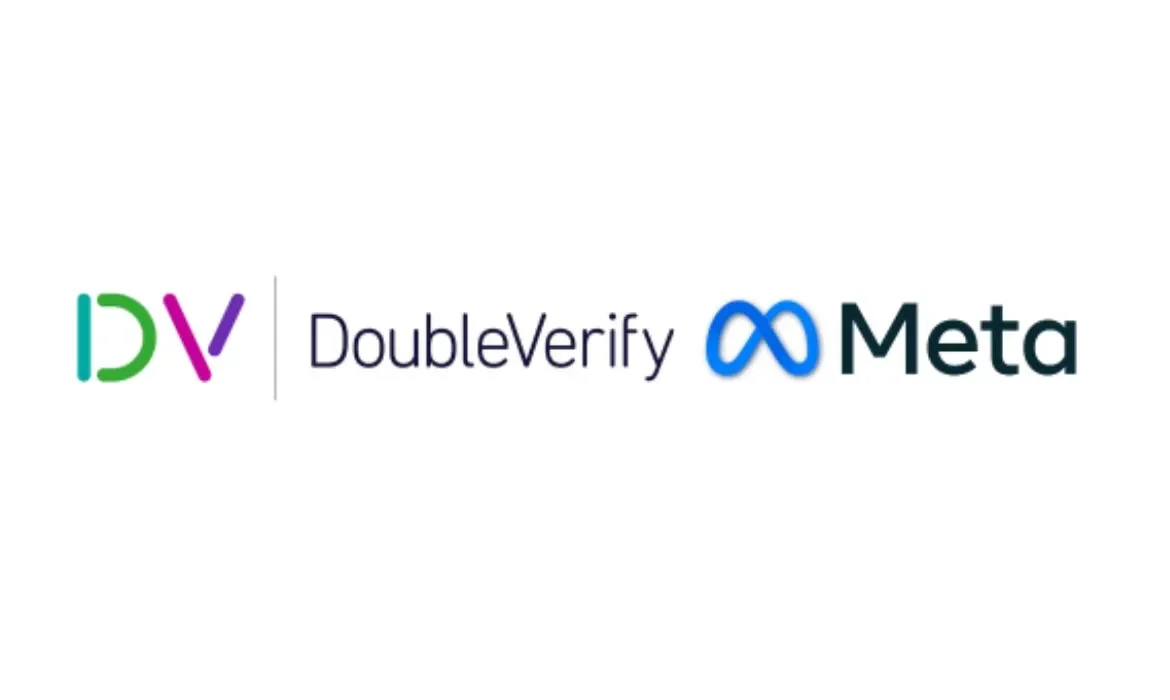

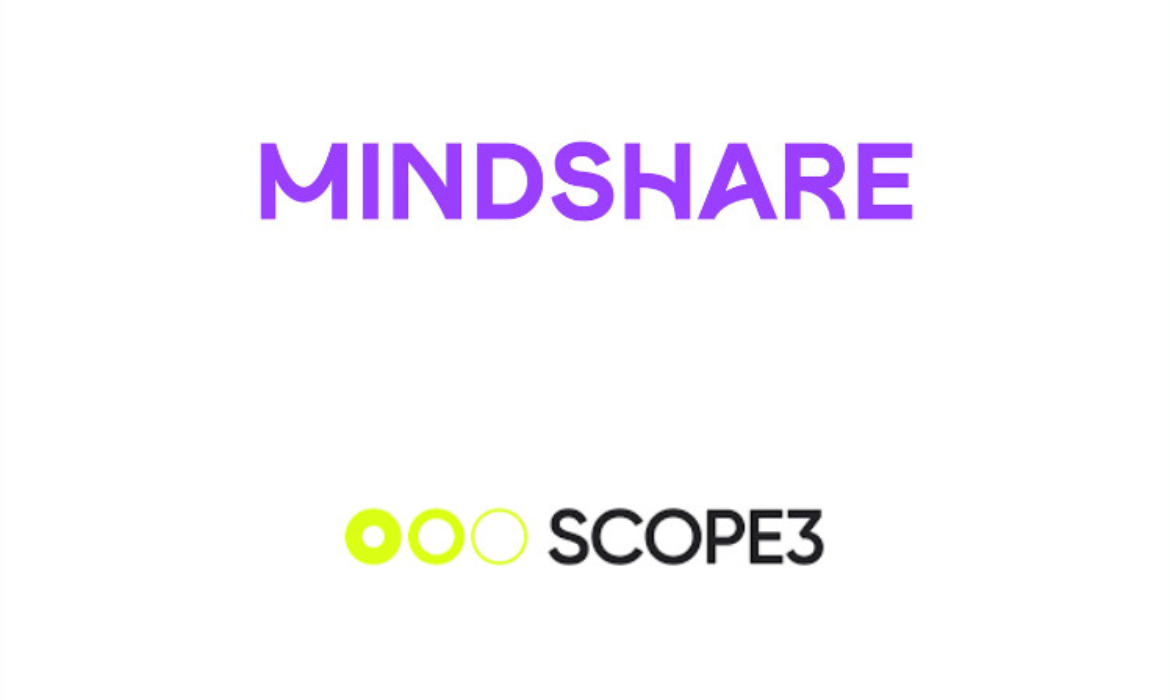
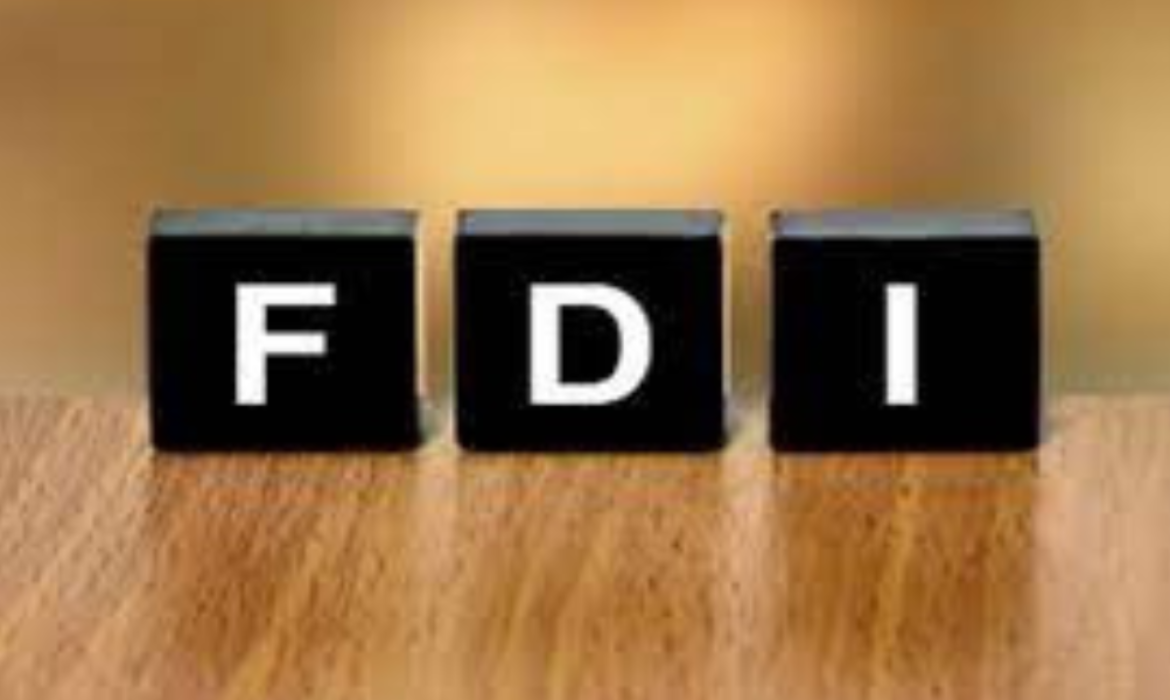
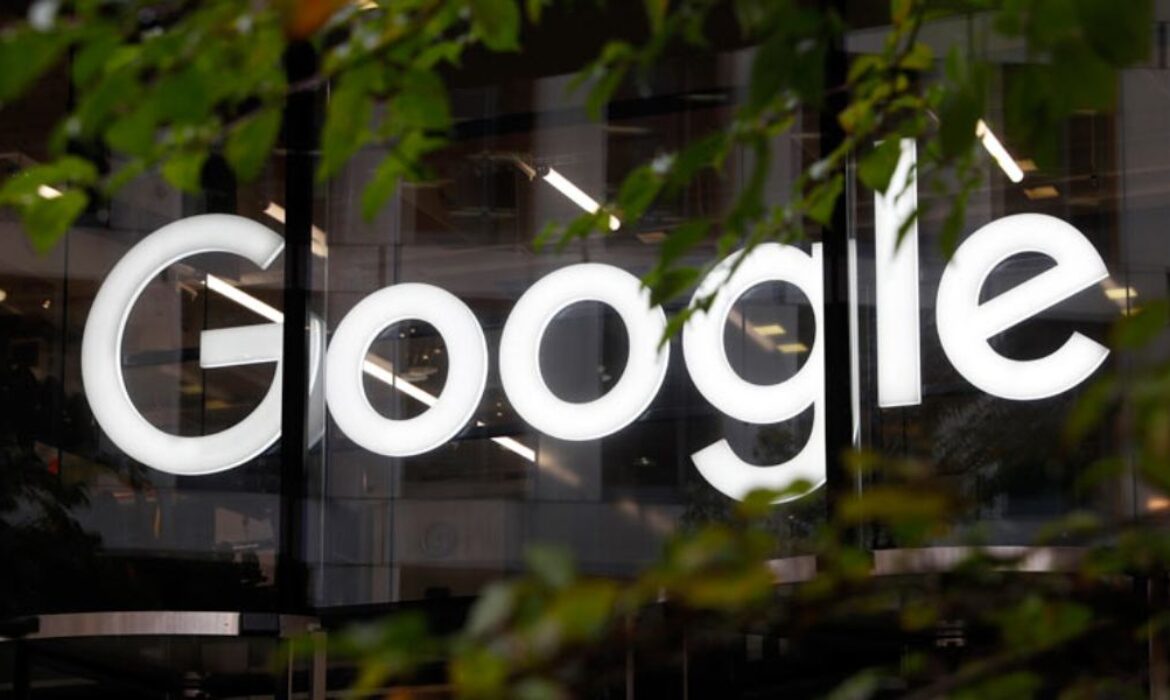
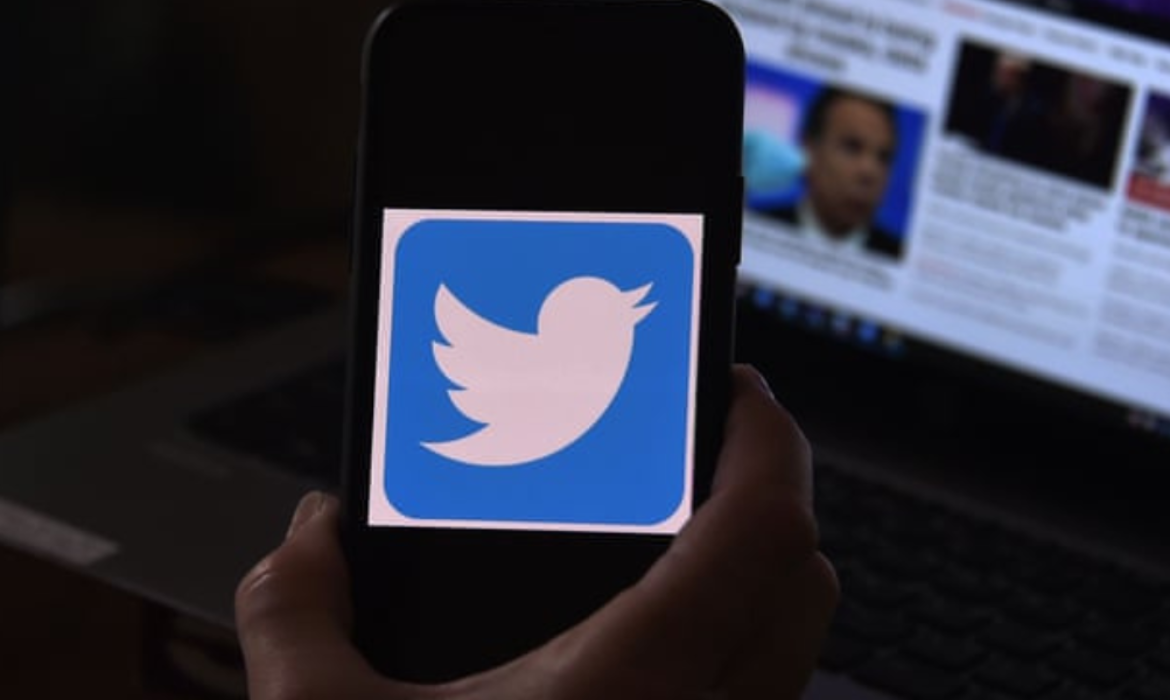


 Google:
Google:  Microsoft:
Microsoft:  Verizon:
Verizon: Omnicon
Omnicon
